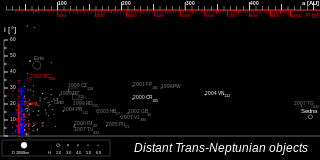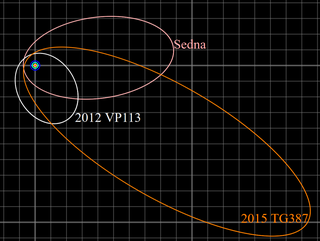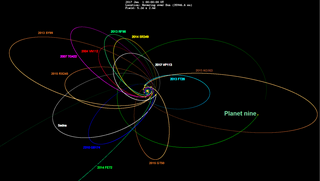
Sedna is a dwarf planet in the outermost reaches of the Solar System discovered in 2003. Spectroscopy has revealed that Sedna's surface composition is largely a mixture of water, methane, and nitrogen ices with tholins, similar to those of some other trans-Neptunian objects. Its surface is one of the reddest among Solar System objects. Sedna, within estimated uncertainties, is tied with Ceres as the largest planetoid not known to have a moon. It has a diameter of approximately 1,000 km ; its mass is unknown.

(148209) 2000 CR105 is a trans-Neptunian object and the tenth-most-distant known object in the Solar System as of 2015. Considered a detached object, it orbits the Sun in a highly eccentric orbit every 3,305 years at an average distance of 222 astronomical units (AU).

(87269) 2000 OO67 (prov. designation:2000 OO67) is a trans-Neptunian object, approximately 64 kilometers (40 miles) in diameter, on a highly eccentric orbit in the outermost region of the Solar System. It was discovered by astronomers at the Chilean Cerro Tololo Inter-American Observatory on 29 July 2000.

2006 QH181, also written as 2006 QH181, is a trans-Neptunian object (TNO) in the scattered disc. Its orbit is currently too poorly determined (U=6) to know whether it is in a resonance with Neptune.
474640 Alicanto, provisionally designated 2004 VN112, is a detached extreme trans-Neptunian object. It was discovered on 6 November 2004, by American astronomer Andrew C. Becker at Cerro Tololo Inter-American Observatory in Chile. It never gets closer than 47 AU from the Sun (near the outer edge of the main Kuiper belt) and averages more than 300 AU from the Sun. Its large eccentricity strongly suggests that it was gravitationally scattered onto its current orbit. Because it is, like all detached objects, outside the current gravitational influence of Neptune, how it came to have this orbit cannot yet be explained. It was named after Alicanto, a nocturnal bird in Chilean mythology.

Detached objects are a dynamical class of minor planets in the outer reaches of the Solar System and belong to the broader family of trans-Neptunian objects (TNOs). These objects have orbits whose points of closest approach to the Sun (perihelion) are sufficiently distant from the gravitational influence of Neptune that they are only moderately affected by Neptune and the other known planets: This makes them appear to be "detached" from the rest of the Solar System, except for their attraction to the Sun.

(523622) 2007 TG422, provisional designation 2007 TG422, is a trans-Neptunian object on a highly eccentric orbit in the scattered disc region at the edge of Solar System. Approximately 260 kilometers (160 miles) in diameter, it was discovered on 3 October 2007 by astronomers Andrew Becker, Andrew Puckett and Jeremy Kubica during the Sloan Digital Sky Survey at Apache Point Observatory in New Mexico, United States. According to American astronomer Michael Brown, the bluish object is "possibly" a dwarf planet. It belongs to a group of objects studied in 2014, which lead to the proposition of the hypothetical Planet Nine.
(445473) 2010 VZ98, provisional designation 2010 VZ98, is a trans-Neptunian object of the scattered disc, orbiting the Sun in the outermost region of the Solar System. It has a diameter of approximately 400 kilometers.
2010 EU65 is a centaur, approximately 64 kilometers (40 miles) in diameter, orbiting the Sun in the outer Solar System. The object is also a promising Uranus horseshoe librator candidate. It was first observed on 13 March 2010, by American astronomers David Rabinowitz and Suzanne Tourtellotte, observing from Cerro Tololo and La Silla Observatory in Chile. As of 2021, it has neither been numbered nor named.

2012 DR30 is a trans-Neptunian object and centaur from the scattered disk and/or inner Oort cloud, located in the outermost region of the Solar System. The object with a highly eccentric orbit of 0.99 was first observed by astronomers with the Spacewatch program at Steward Observatory on 31 March 2009. It measures approximately 188 kilometers (120 miles) in diameter.

2013 BL76 is a trans-Neptunian object and centaur from the scattered disk and Inner Oort cloud approximately 30 kilometers in diameter.

2012 VP113, also known by its nickname "Biden", is a trans-Neptunian object of the sednoid population, located in the outermost reaches of the Solar System. It was first observed on 5 November 2012 by American astronomers Scott Sheppard and Chad Trujillo at the Cerro Tololo Inter-American Observatory in Chile. The discovery was announced on 26 March 2014. The object probably measures somewhere between 300 and 1000 km in diameter, possibly large enough to be a dwarf planet.

A sednoid is a trans-Neptunian object with a perihelion well beyond the Kuiper cliff at 47.8 AU. Only four objects are known from this population: 90377 Sedna, 2012 VP113, 541132 Leleākūhonua (2015 TG387), and 2021 RR205, but it is suspected that there are many more. All four have perihelia greater than 55 AU. These objects lie outside an apparently nearly empty gap in the Solar System and have no significant interaction with the planets. They are usually grouped with the detached objects. Some astronomers consider the sednoids to be inner Oort cloud objects (OCOs), though the inner Oort cloud, or Hills cloud, was originally predicted to lie beyond 2,000 AU, beyond the aphelia of the four known sednoids.

2014 FC69 is a trans-Neptunian object of the scattered disc on an eccentric orbit in the outermost region of the Solar System. It was first observed on 25 March 2014, by American astronomers Scott Sheppard and Chad Trujillo at the Cerro Tololo Observatory in Chile. It is one of the most distant objects from the Sun, even further away than Sedna.

2014 FE72 is a trans-Neptunian object first observed on 26 March 2014, at Cerro Tololo Inter-American Observatory in La Serena, Chile. It is a possible dwarf planet, a member of the scattered disc, whose orbit extends into the inner Oort cloud. Discovered by Scott Sheppard and Chad Trujillo, the object's existence was revealed on 29 August 2016. Both the orbital period and aphelion distance of this object are well constrained. 2014 FE72 had the largest barycentric aphelion until 2018. However, the heliocentric aphelion of 2014 FE72 is second among trans-Neptunian objects (after the damocloid 2017 MB7). As of 2023, it is about 66 AU (9.9 billion km) from the Sun.

2013 FT28 is a trans-Neptunian object. The existence of the TNO was discovered on 16 March 2013 at Cerro Tololo Observatory, La Serena and revealed on 30 August 2016.

2013 FS28 is an extreme trans-Neptunian object from the extended scattered disc on a highly eccentric orbit in the outermost region of the Solar System. It measures approximately 466 kilometers (290 miles) in diameter. The detached, extended scattered disc object belongs to the group of extreme trans-Neptunian objects. It was first observed on 16 March 2013, by American astronomers Scott Sheppard and Chad Trujillo at the Cerro Tololo Observatory in Chile.

2015 BP519, nicknamed Caju, is an extreme trans-Neptunian object from the scattered disc on a highly eccentric and inclined orbit in the outermost region of the Solar System. It was first observed on 17 January 2015, by astronomers with the Dark Energy Survey at Cerro Tololo Observatory (W84) in Chile. It has been described as an extended scattered disc object (ESDO), and fits into the group of extreme objects that led to the prediction of Planet Nine, and has the highest orbital inclination of any of these objects.

2018 VG18 is a distant trans-Neptunian object that was discovered well beyond 100 AU (15 billion km) from the Sun. It was first observed on 10 November 2018 by astronomers Scott Sheppard, David Tholen, and Chad Trujillo during a search for distant trans-Neptunian objects whose orbits might be gravitationally influenced by the hypothetical Planet Nine. They announced their discovery on 17 December 2018 and nicknamed the object "Farout" to emphasize its distance from the Sun.


















